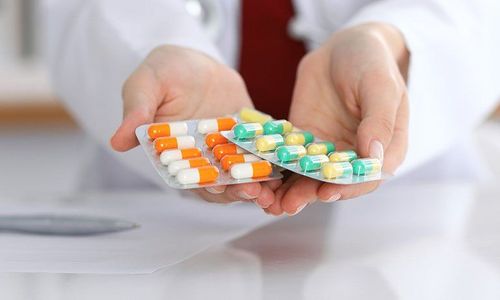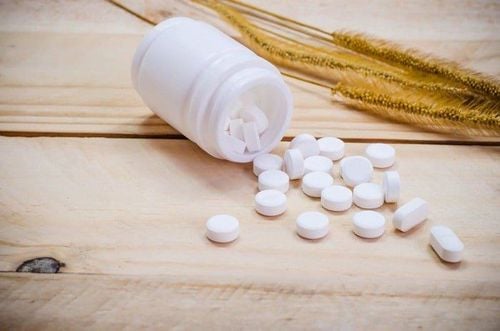This is an automatically translated article.
Opetradol is indicated in the treatment of moderate to severe pain. In order to use the drug effectively, patients need to learn some information about the uses, dosage and notes when using Opetradol in the article below.1. What is Opetradol?
Opetradol belongs to the group of pain relievers, antipyretics, non-steroidal anti-inflammatory drugs, treatment of Gout and bone and joint diseases. Opetradol is prepared in the form of film-coated tablets, packing specifications: Box of 3 blisters x 10 tablets; Box of 10 blisters x 10 tablets.Drug ingredients Opetradol:
Paracetamol content 325mg: Paracetamol is a central analgesic with the mechanism and location of analgesic effect not yet clearly defined. Tramadol HCl content 37.5mg: Tramadol is a central pain reliever. The drug occurs by at least two mechanisms, binding of the parent and active metabolite (M1) to the Mu-opioid receptor as well as mild inhibition of the reuptake of norepinephrine and serotonin. When evaluated in laboratory animals, the combination of Paracetamol and Tramadol has shown a synergistic effect.
2. Indications for taking Opetradol
Opetradol is indicated in the treatment of moderate to severe pain.3. Dosage and how to use Opetradol
Reference dose of Opetradol is as follows:
Adults and children over 12 years old: The maximum dose of Opetradol is 1-2 tablets every 4 to 6 hours and not more than 8 tablets in 1 day. Children (under 12 years): The safety and effectiveness of Opetradol have not been studied in children. Elderly (over 65 years): There were no differences in safety or pharmacokinetic properties between patients over 65 years of age and younger patients. How to use Opetradol:
Take Opetradol before or after meals. Food does not affect the therapeutic effect of the drug. Note: The above dose of Opetradol is for reference only. The specific dose of Opetradol will depend on the condition and the progression of the disease. To get the right dose of Opetradol, patients need to consult their doctor/pharmacist.
4. Overdose and treatment
Manifestations of drug overdose can be signs or symptoms of Tramadol toxicity, Paracetamol or both.
Tramadol: Symptoms include respiratory failure, convulsions, coma, cardiac arrest and death. Paracetamol: Symptoms such as gastrointestinal irritation, loss of appetite, nausea and vomiting, malaise, paleness, sweating. Symptoms of hepatotoxicity may appear 48 - 72 hours after taking Opetradol. How to handle:
Notify the doctor or take the patient to the nearest medical facility for timely treatment.
5. Contraindications to the use of Opetradol
Do not use Opetradol for the following cases:
Breastfeeding women because the safety of Opetradol for infants and young children has not been studied; People who are sensitive to any of the ingredients and active ingredients in Opetradol.
6. Drug interactions
Possible interactions when Opetradol is used concurrently with the following drugs:
MAO inhibitors and serotonin reuptake inhibitors: Concomitant use of Opetradol increases the risk of adverse events, including including seizures and serotonin syndrome ; Carbamazepine: Concomitant use of Opetradol significantly increases the metabolism of the active substance Tramadol in the drug. The analgesic effect of Tramadol in Opetradol may be reduced; Quinidine: Increases Tramadol content; Drugs belonging to the Warfarin group; CYP2D6 inhibitors; Cimetidine. In order to avoid unwanted interactions when using Opetradol, patients should inform their doctor/pharmacist of all medications, dietary supplements, vitamins, etc. they are taking.
7. Opetradol side effects
The most common side effects of Opetradol are on the central nervous system and digestive system with symptoms such as nausea, dizziness, drowsiness.Some of the following side effects are also possible, but less frequently:
Asthenia, fatigue; Strong emotion; Headache, shivering; Stomachache ; Constipation or diarrhea; Indigestion, flatulence; Dry mouth, loss of appetite; Anxiety, confusion; Irritability, insomnia, restlessness; Itching, skin rash; Increased sweating. Rare clinical reports of adverse events possibly related to Opetradol include:
Chest pain, chills; Faint; Smoking withdrawal syndrome; Increase/decrease in blood pressure; Overbalance; Convulsions, muscle tension; Migraine; Involuntary muscle contractions; Paresthesias; Difficulty swallowing; Gastrointestinal bleeding ; Tongue edema; Tinnitus; Heart rhythm disturbances; Palpitations, rapid pulse; Abnormal liver tests; Weight loss; Forgetfulness, loss of consciousness; Depression; Drug abuse; Mood swings, hallucinations; Impotent; Having unusual ideas; Anemia; Shortness of breath; Albuminuria; Urinary disorders; Unclear vision; Other side effects of active ingredient Tramadol before clinical trial and after marketing:
Orthostatic hypertension; Anaphylactic reactions; Hives; Stevens-Johnson syndrome ; Cognitive dysfunction; Having suicidal thoughts; Hepatitis; Creatinine is elevated; Serotonin syndrome. During the course of treatment, if there are any abnormal symptoms suspected of using Opetradol, the patient should notify the treating doctor/pharmacist for appropriate treatment.
8. Be careful when using Opetradol
Use Opetradol with caution with serotonin reuptake inhibitors, tricyclic compounds, Opioids, MAOIs, sedatives or drugs that lower the seizure threshold; Patients with epilepsy, history or risk of convulsions should use caution when using Opetradol; The risk of respiratory depression is increased in patients at increased risk of respiratory failure or taking high doses of Tramadol with local anesthetics, anesthetics and alcohol; Opetradol should be used with caution in patients with increased intracranial pressure or head trauma; Opetradol should be used with caution in patients with opiate addiction because of the potential for relapse; Opetradol should be used with caution in patients with chronic alcoholism because of the risk of hepatotoxicity; The use of Naloxone to treat an overdose of Tramadol may increase the risk of convulsions; For patients with creatinine clearance less than 30ml/min, no more than 2 Opetradol tablets should be taken every 12 hours; Opetradol should be used with caution in patients with severe hepatic impairment; Do not exceed the indicated dose of Opetradol. Do not take Opetradol with other medicines containing Paracetamol or Tramadol. Above is information about uses, dosage and precautions when using Opetradol. To ensure safety for your health and maximize the effectiveness of your treatment, you need to take Opetradol exactly as directed by your doctor. Store Opetradol at room temperature, away from direct sunlight.
Please dial HOTLINE for more information or register for an appointment HERE. Download MyVinmec app to make appointments faster and to manage your bookings easily.













